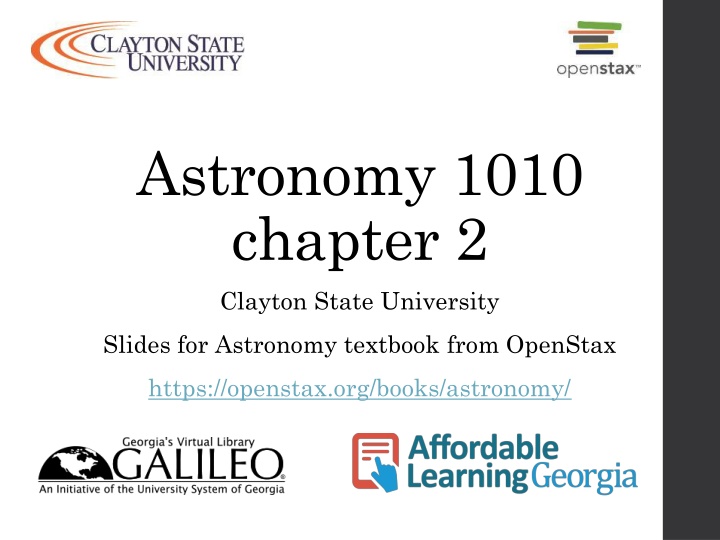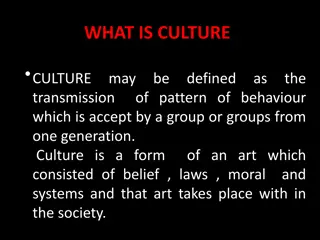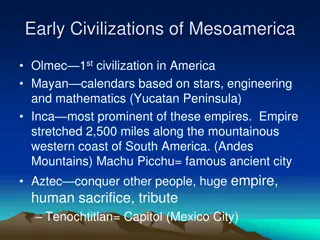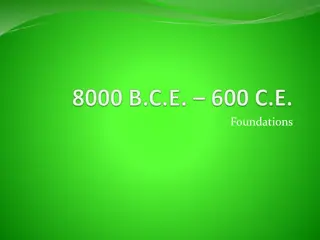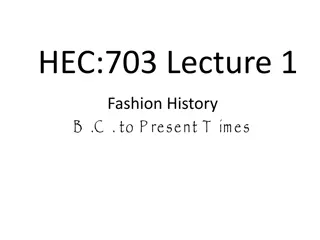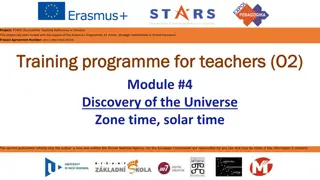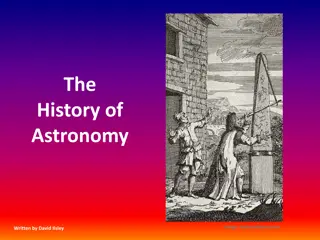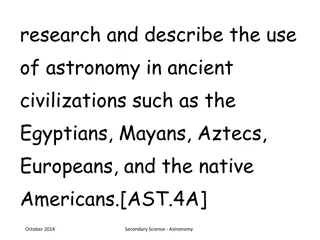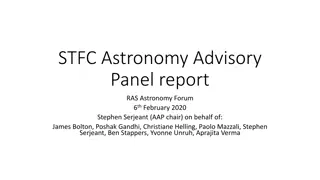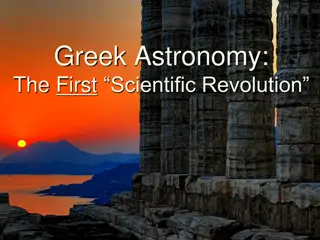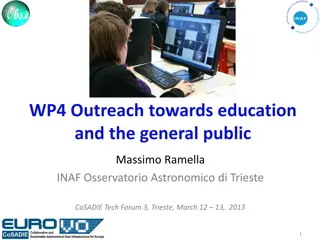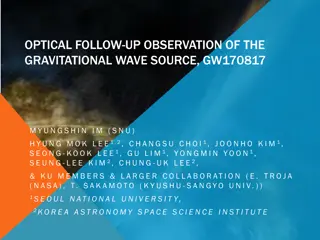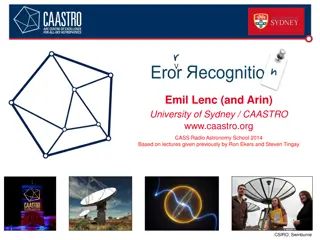Ancient Astronomy and Cosmologies Across Different Civilizations
Ancient civilizations like Babylonian, Assyrian, Egyptian, and Chinese had profound knowledge of astronomy, including tracking celestial events, developing calendars, and recording astronomical phenomena. The Greeks contributed to cosmology, contemplating the nature of the cosmos. Beliefs in a spherical Earth and celestial spheres were prevalent in these early cosmologies.
Download Presentation

Please find below an Image/Link to download the presentation.
The content on the website is provided AS IS for your information and personal use only. It may not be sold, licensed, or shared on other websites without obtaining consent from the author.If you encounter any issues during the download, it is possible that the publisher has removed the file from their server.
You are allowed to download the files provided on this website for personal or commercial use, subject to the condition that they are used lawfully. All files are the property of their respective owners.
The content on the website is provided AS IS for your information and personal use only. It may not be sold, licensed, or shared on other websites without obtaining consent from the author.
E N D
Presentation Transcript
Astronomy 1010 chapter 2 Clayton State University Slides for Astronomy textbook from OpenStax https://openstax.org/books/astronomy/
Astronomy around the ancient world Ancient Babylonian, Assyrian, and Egyptian astronomers knew the approximate length of the year. The Egyptians of 3000 years ago, for example, adopted a calendar based on a 365-day year. They kept careful track of the rising time of the bright star Sirius in the predawn sky, which has a yearly cycle that corresponded with the flooding of the Nile River. The Chinese also had a working calendar; they determined the length of the year at about the same time as the Egyptians. The Chinese also recorded comets, bright meteors, and dark spots on the Sun. Later, Chinese astronomers kept careful records of guest stars those that are normally too faint to see but suddenly flare up to become visible to the unaided eye for a few weeks or months. We still use some of these records in studying stars that exploded a long time ago. 2
Astronomy around the ancient world In Egypt: merkhet In China: This is a star map for the celestial globe of Su Song (1020-1101), a Chinese scientist and mechanical engineer of the Song Dynasty (960-1279). It was first published in the year 1092 3
Astronomy around the ancient world An illustration from al-Biruni's astronomical works, explains the different phases of the moon. (city of Khiva,[1] Khwarezm, Afrighid dynasty (modern-day Uzbekistan)) Jantar Mantar, ancient astronomical observatory, Jaipur, Rajasthan, India 4
Ancient Cosmologies The Greek word cosmos is the universe literally. Using the word cosmos rather than the word universe implies viewing the universe as a complex and orderly system or entity, the opposite of chaos. The cosmos, and our understanding of the reasons for its existence and significance, are studied in cosmology - a very broad discipline covering any scientific, religious, or philosophical contemplation of the cosmos and its nature, or reasons for existing. So Cosmology is a set of knowledge and believes one has about the universe, how it was made, what makes it work and how and if it has an end. 5
Cosmology of Greece Belief in a spherical Earth may have stemmed from the time of Pythagoras, a philosopher and mathematician who lived 2500 years ago. He believed circles and spheres to be perfect forms and suggested that Earth should therefore be a sphere. As evidence that the gods liked spheres, the Greeks cited the fact that the Moon is a sphere The writings of Aristotle (384 322 BCE), the tutor of Alexander the Great, summarize many of the ideas of his day. They describe how the progression of the Moon s phase - its apparent changing shape - results from our seeing different portions of the Moon s sunlit hemisphere as the month goes by (see Earth, Moon, and Sky). Aristotle also knew that the Sun has to be farther away from Earth than is the Moon because occasionally the Moon passed exactly between Earth and the Sun and hid the Sun temporarily from view - solar eclipse. 6
Earth/Round Aristotle cited convincing arguments that Earth must be round. First is the fact that as the Moon enters or emerges from Earth s shadow during an eclipse of the Moon, the shape of the shadow seen on the Moon is always round. Only a spherical object always produces a round shadow. But he lied to Alexander the Great about that! If Earth were a disk, for example, there would be some occasions when the sunlight would strike it edge-on and its shadow on the Moon would be a line. As a second argument, Aristotle explained that travelers who go south a significant distance are able to observe stars that are not visible farther north. And the height of the North Star the star nearest the north celestial pole - decreases as a traveler moves south. On a flat Earth, everyone would see the same stars overhead. The only possible explanation is that the traveler must have moved over a curved surface on Earth, showing stars from a different angle. 7
The world map in ~300 B.C. given the dates of Alexander s life (about 356 323 BC) it s possible that his exploits actually added territories such as India to the world map of Europeans 8
Earth Circumference The Greeks not only knew Earth was round, but also they were able to measure its size. The first fairly accurate determination of Earth s diameter was made in about 200 BCE by Eratosthenes (276 194 BCE), a Greek living in Alexandria, Egypt. His method was a geometric one, based on observations of the Sun. Eratosthenes was told that on the first day of summer at Syene, Egypt (near modern Aswan), sunlight struck the bottom of a vertical well at noon. This indicated that the Sun was directly over the well meaning that Syene was on a direct line from the center of Earth to the Sun. At the corresponding time and date in Alexandria, Eratosthenes observed the shadow a column made and saw that the Sun was not directly overhead, but was slightly south of the zenith, so that its rays made an angle with the vertical equal to about 1/50 of a circle (7 ). Because the Sun s rays striking the two cities are parallel to one another, why would the two rays not make the same angle with Earth s surface? Eratosthenes reasoned that the curvature of the round Earth meant that straight up was not the same in the two cities. And the measurement of the angle in Alexandria, he realized, allowed him to figure out the size of Earth. Alexandria, he saw, must be 1/50 of Earth s circumference north of Syene. Alexandria had been measured to be 5000 stadia north of Syene. (The stadium was a Greek unit of length, derived from the length of the racetrack in a stadium.) Eratosthenes thus found that Earth s circumference must be 50 5000, or 250,000 stadia. 9
Earth Circumference It is not possible to evaluate precisely the accuracy of Eratosthenes solution because there is doubt about which of the various kinds of Greek stadia he used as his unit of distance. If it was the common Olympic stadium, his result is about 20% too large. According to another interpretation, he used a stadium equal to about 1/6 kilometer, in which case his figure was within 1% of the correct value of 40,000 kilometers. Even if his measurement was not exact, his success at measuring the size of our planet by using only shadows, sunlight, and the power of human thought was one of the greatest intellectual achievements in history. 10
Hipparchus Perhaps the greatest astronomer of antiquity was Hipparchus, born in Nicaea in what is present-day Turkey. He erected an observatory on the island of Rhodes around 150 BC, when the Roman Republic was expanding its influence throughout the Mediterranean region. There he measured, as accurately as possible, the positions of objects in the sky, compiling a pioneering star catalog with about 850 entries. He designated celestial coordinates for each star, specifying its position in the sky, just as we specify the position of a point on Earth by giving its latitude and longitude. 11
Hipparchus and Precession By observing the stars and comparing his data with older observations, Hipparchus made one of his most remarkable discoveries: the position in the sky of the north celestial pole had altered over the previous century and a half. Hipparchus deduced correctly that this had happened not only during the period covered by his observations, but was in fact happening all the time: the direction around which the sky appears to rotate changes slowly but continuously. Today, we understand that the direction in which Earth s axis points does indeed change slowly but regularly a motion we call precession. If you have ever watched a spinning top wobble, you observed a similar kind of motion. 12
Hipparchus and Magnitudes Hippatchus also divided the stars into apparent magnitudes according to their apparent brightness. He called the brightest stars of the first magnitude ; the next brightest stars of the second magnitude In 1856, Norman Robert Pogson formalized the system by defining a first magnitude star as a star that is 100 times as bright as a sixth-magnitude star, thereby establishing the logarithmic scale still in use today. Total of 5 magnitudes at the time: from 1 to 6 Total difference in brightness ~100 times from 1 to 6 (1 being the brightest) Difference between any two adjacent magnitudes m and m+1 (like 4 and 5, or 2 and 3 etc.) would be 5100 2.51 Apparent magnitudes formula: 13
Magnitudes of common stars Can only be measured with respect to some reference: Vega is defined as 0 Depends on distance to object Magnitudes in log notation: 14
Astronomy in Ancient Rome The last great astronomer of the Roman era was Claudius Ptolemy (or Ptolemaeus), who flourished in Alexandria in about the year 140. He wrote a mammoth compilation of astronomical knowledge, which today is called by its Arabic name, Almagest (meaning The Greatest ). Almagest does not deal exclusively with Ptolemy s own work; it includes a discussion of the astronomical achievements of the past, principally those of Hipparchus. Today, it is our main source of information about the work of Hipparchus and other Greek astronomers. 15
Retrograde motion of planets In ancient times, astronomers noted how certain lights moved across the sky, as opposed to the "fixed stars", which maintained a constant relative position in the sky.Ancient Greeks called these lights (plan tes asteres, "wandering stars") or simply (plan tai, "wanderers"), from which today's word "planet" was derived. 16
Ptolemaic system Because the Greeks believed that celestial motions had to be circles, Ptolemy had to construct his model using circles alone. To do it, he needed dozens of circles, some moving around other circles, in a complex structure. Ptolemy solved the problem of explaining the observed motions of planets by having each planet revolve in a small orbit called an epicycle. The center of the epicycle then revolved about Earth on a circle called a deferent Planets actual behavior cannot be represented accurately by a scheme of uniform circular motions. In order to match the observed motions of the planets, Ptolemy had to center the deferent circles, not on Earth, but at points some distance from Earth. In addition, he introduced uniform circular motion around yet another axis, called the equant point. All of these considerably complicated his scheme. 17
Through dark ages, middle ages onto renaissance Questions to ask self: how did Roman empire fall and why? What prepared the Dark Ages and what supported them? How middle ages have led to Crusades? During the so-called Dark Ages much of the knowledge of the Greek scientists was lost. Some manuscripts were saved in the vaults of dark monasteries but most went the way of those destroyed with the Library of Alexandria. In these years the Arabs had kept the science alive and even made discoveries of their own. Though he might not want to admit it, our medieval scholar knew the debt that he owed to the infidels. Many of the star names used today are Arabic: Rigel, Deneb, Aldebaran, Antares and Vega, to name a few. Knowledge acquired from the Arabs during the time of the Crusades was vital to relearning what the ancients had known a thousand years before. Finally, the fall of Constantinople to the Turks in 1453 brought to Italy many Greek scholars and their manuscripts. Slowly, Europe reawakened. Astronomy in the early Renaissance was dominated by John Muller of Konigsberg (1436-1476) During the course of his short and nomadic life Muller, who was better known as Regiomontantus, popularized the use of solid celestial spheres in conjunction with the Ptolemaic universe. In doing so he was to limit the size of the Universe to that of the largest sphere, upon which the stars were affixed. 19
Through dark ages, middle ages onto renaissance Leonardo da Vinci (1452-1519) was, in addition to a painter, sculptor, engineer and mathematician, an astronomer as well. His major contribution to the science was his explanation of why, when the moon is at crescent, the areas not lit by sunlight are still faintly visible. Da Vinci correctly surmised that these areas were being lit by "earthshine", that is, sunlight reflecting Off the earth onto the moon. This concept did much to break down the supposed barrier between the earth and celestial objects. Even with the contributions made by astronomers of the early Renaissance, people of the time still maintained many mistaken ideas about the nature of the Universe. The most important of these, of course, was the siting of the earth as the center of the Universe. Our ancestors had no concept of what kept the planets in orbit. Some believed that the angels pushed the crystal spheres around the Earth. But all believed that the Earth was the center of the Universe. They could see no reason that Ptolemy was wrong. Some discrepancy was noticed between the positions that Ptolemy had predicted for the planets. But tables were revised and no one was terribly concerned with the errors 20
Nicolas Copernicus Nicolaus Copernicus (19 February 1473 24 May 1543) was a Renaissance-era mathematician and astronomer who formulated a model of the universe that placed the Sun rather than the Earth at the center of the universe, in all likelihood independently of Aristarchus of Samos, The publication of Copernicus' model in his book De revolutionibus orbium coelestium (On the Revolutions of the Celestial Spheres), just before his death in 1543 Copernicus was born and died in Royal Prussia, a region that had been part of the Kingdom of Poland since 1466. A polyglot and polymath, he obtained a doctorate in canon law and was also a mathematician, astronomer, physician, classics scholar, translator, governor, diplomat, and economist. In 1517 he derived a quantity theory of money a key concept in economics and in 1519 he formulated an economic principle that later will be called Gresham's law. 21
FIGURE 2.18 Phases of Venus. As Venus moves around the Sun, we see changing illumination of its surface, just as we see the face of the Moon illuminated differently in the course of a month. In the case of Copernicus, one example is the prediction that, if Venus circles the Sun, the planet should go through the full range of phases just as the Moon does, whereas if it circles Earth, it should not (Figure 2.18). Also, we should not be able to see the full phase of Venus from Earth because the Sun would then be between Venus and Earth. But in those days, before the telescope, no one imagined testing these predictions.
Giordano Bruno Copernicus' theories were not well received at first. Luther and the Protestants seemed for once in complete agreement with the Pope and the Catholics: Copernicus was wrong. And yet, as we shall see, some scholars were willing to accept it or, at least, give it the benefit of the doubt. One, Giordano Bruno, was to be burnt at the stake for his steadfast defense of the Copernican system in 1600. Another, Galileo, was to be forced to recant his support of the same system as late as 1633. Giordano Bruno (1548 17 February 1600) was an Italian Dominican friar, philosopher, mathematician, poet, and cosmological theorist. He is known for his cosmological theories, which conceptually extended the then-novel Copernican model. He proposed that the stars were distant suns surrounded by their own planets, and he raised the possibility that these planets might foster life of their own, a philosophical position known as cosmic pluralism. He insisted that the universe is infinite and could have no "center". 23
Tycho Brahe Tycho Brahe (14 December 1546 24 October 1601) was a Danish nobleman, astronomer, and writer known for his accurate and comprehensive astronomical and planetary observations. He was born in the then Danish peninsula of Scania. Well known in his lifetime as an astronomer, astrologer and alchemist, he has been described as "the first competent mind in modern astronomy to feel ardently the passion for exact empirical facts." His observations were some five times more accurate than the best available observations at the time. 24
Galileo Galilei Galileo Galilei, (born February 15, 1564, Pisa [Italy] died January 8, 1642, Arcetri, near Florence), Italian natural philosopher, astronomer, and mathematician who made fundamental contributions to the sciences of motion, astronomy, and strength of materials and to the development of the scientific method. His formulation of (circular) inertia, the law of falling bodies, and parabolic trajectories marked the beginning of a fundamental change in the study of motion. His insistence that the book of nature was written in the language of mathematics changed natural philosophy from a verbal, qualitative account to a mathematical one in which experimentation became a recognized method for discovering the facts of nature. Finally, his discoveries with the telescope revolutionized astronomy and paved the way for the acceptance of the Copernican heliocentric system, but his advocacy of that system eventually resulted in an Inquisition process against him. 25
FIGURE 2.20 Telescope Used by Galileo. The telescope has a wooden tube covered with paper and a lens 26 millimeters across.
Constellations on the Ecliptic As Earth revolves around the Sun, we sit on it and see the Sun moving around the sky. The circle in the sky that the Sun appears to make around us in the course of a year is called the ecliptic. This circle (like all circles in the sky) goes through a set of constellations. The ancients thought these constellations, which the Sun (and the Moon and planets) visited, must be special and incorporated them into their system of astrology. Note that at any given time of the year, some of the constellations crossed by the ecliptic are visible in the night sky; others are in the day sky and are thus hidden by the brilliance of the Sun. 27
Astrology or pseudoscience Astrology is the study of the movements and relative positions of celestial objects as a means of divining information about human affairs and terrestrial events. Astrology has been dated to at least the 2nd millennium BCE, and has its roots in calendrical systems used to predict seasonal shifts and to interpret celestial cycles as signs of divine communications. Many cultures have attached importance to astronomical events, and some such as the Indians, Chinese, and Maya developed elaborate systems for predicting terrestrial events from celestial observations. Western astrology, one of the oldest astrological systems still in use, can trace its roots to 19th 17th century BCE Mesopotamia, from which it spread to Ancient Greece, Rome, the Arab world and eventually Europe. Contemporary Western astrology is often associated with systems of horoscopes that purport to explain aspects of a person's personality and predict significant events in their lives based on the positions of celestial objects; QUESTION: why do you think people started to believe that stars affect their lives in such profound manner? 28
